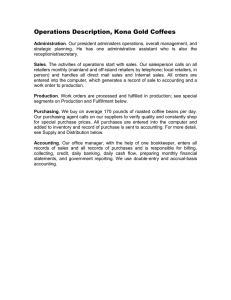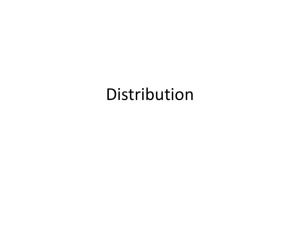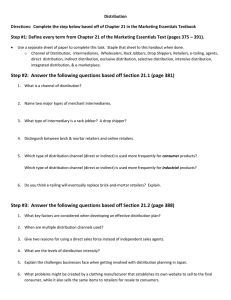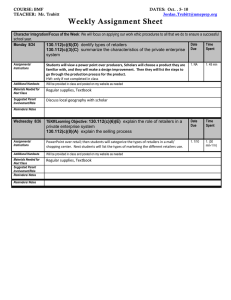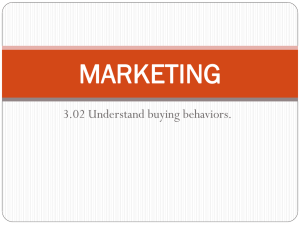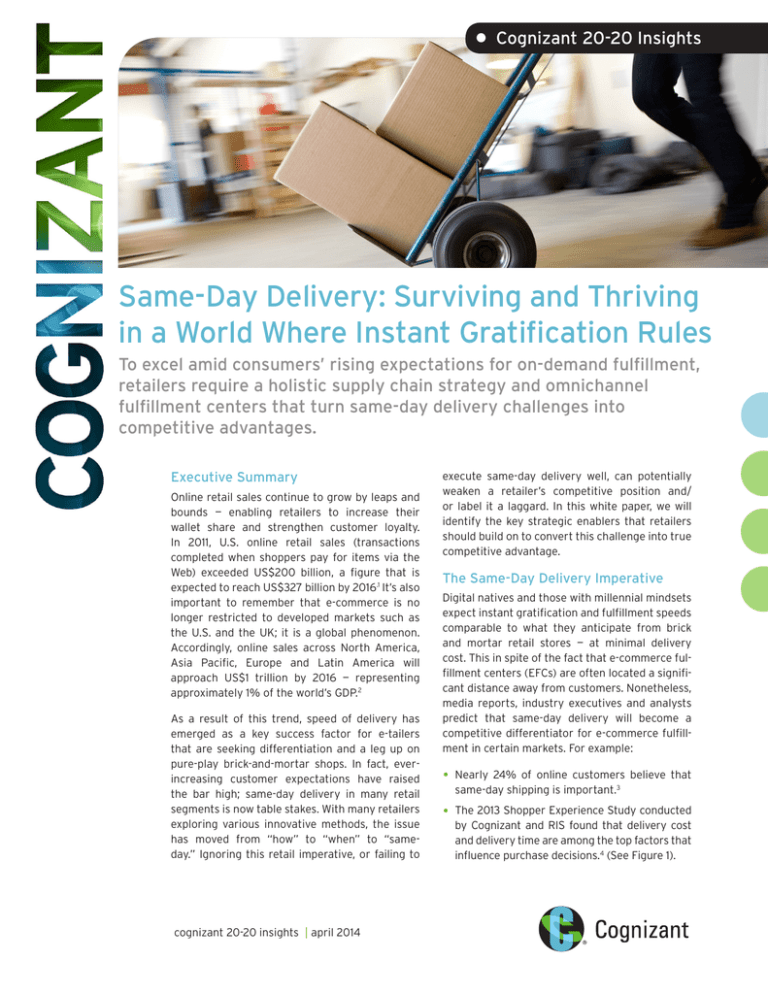
• Cognizant 20-20 Insights
Same-Day Delivery: Surviving and Thriving
in a World Where Instant Gratification Rules
To excel amid consumers’ rising expectations for on-demand fulfillment,
retailers require a holistic supply chain strategy and omnichannel
fulfillment centers that turn same-day delivery challenges into
competitive advantages.
Executive Summary
Online retail sales continue to grow by leaps and
bounds — enabling retailers to increase their
wallet share and strengthen customer loyalty.
In 2011, U.S. online retail sales (transactions
completed when shoppers pay for items via the
Web) exceeded US$200 billion, a figure that is
expected to reach US$327 billion by 2016.1 It’s also
important to remember that e-commerce is no
longer restricted to developed markets such as
the U.S. and the UK; it is a global phenomenon.
Accordingly, online sales across North America,
Asia Pacific, Europe and Latin America will
approach US$1 trillion by 2016 — representing
approximately 1% of the world’s GDP.2
As a result of this trend, speed of delivery has
emerged as a key success factor for e-tailers
that are seeking differentiation and a leg up on
pure-play brick-and-mortar shops. In fact, everincreasing customer expectations have raised
the bar high; same-day delivery in many retail
segments is now table stakes. With many retailers
exploring various innovative methods, the issue
has moved from “how” to “when” to “sameday.” Ignoring this retail imperative, or failing to
cognizant 20-20 insights | april 2014
execute same-day delivery well, can potentially
weaken a retailer’s competitive position and/
or label it a laggard. In this white paper, we will
identify the key strategic enablers that retailers
should build on to convert this challenge into true
competitive advantage.
The Same-Day Delivery Imperative
Digital natives and those with millennial mindsets
expect instant gratification and fulfillment speeds
comparable to what they anticipate from brick
and mortar retail stores — at minimal delivery
cost. This in spite of the fact that e-commerce fulfillment centers (EFCs) are often located a significant distance away from customers. Nonetheless,
media reports, industry executives and analysts
predict that same-day delivery will become a
competitive differentiator for e-commerce fulfillment in certain markets. For example:
• Nearly 24% of online customers believe that
same-day shipping is important.3
• The 2013 Shopper Experience Study conducted
by Cognizant and RIS found that delivery cost
and delivery time are among the top factors that
influence purchase decisions.4 (See Figure 1).
Top Factors That Influence Online Purchase Decisions
4.5
4.5
Delivery Cost
Competitive Price, Markdowns, Discounts and Promotions
4.1
Ease of Returning Products
4.0
Delivery Time
4.0
Fast, Easy Checkout
(On a scale
l off 1 tto 5)
Figure 1
Over the last decade, consumers have become
increasingly comfortable purchasing more
product categories online — pharmacy, new
gadget releases and gift items, for instance.
Many can’t wait, and purchase from brick-andmortar stores instead of ordering online. This
gives retailers the opportunity to further increase
their online sales of popular product categories
by developing the ability to economically execute
same-day delivery.
The Competitive Landscape
the product from the brick-and-mortar store
and carried it home. In online fulfillment,
this process can be costly, and is usually
performed by the retailer. As shown in Figure 1,
our research confirms that online customers
consider the delivery cost, along with delivery
time, among the top factors that influence their
purchasing decisions. This presents a challenge
to retailers to increase the speed of fulfillment
with little additional cost to buyers.
• Volume: Today, retailers that provide same-day
delivery service offer it at a premium cost. The
reason? Most of these companies are struggling
to find the same-day “sweet spot” — the perfect
combination of the right number of orders in a
common region and the right carriers to make
the economics of same-day delivery work.
These retailers must also increase the volume
of products they ship for same-day delivery in
order to make the entire strategy economically
viable.
The battle for same-day delivery has already
begun. Be it giants like eBay, Walmart or
Amazon, or niche players such as KuaiShubAo.
com, retailers are raising the bar by reducing
the fulfillment time and pushing the cut-off time
for same-day delivery. The sidebar on page 3
provides a snapshot of leading player strategies.
Key Challenges
• Distance:
Traditional retailers do not stock
inventory that can be fulfilled within hours to
all customers. And typically, most EFCs are
not located near buyers, making it impossible
to deliver goods to customers on the same
day that orders are received. Since moving
inventory closer to customers often involves
storing it in multiple locations, the trade-off in
storage/capital costs must be weighed against
the service/sales impact. This has forced many
retailers to re-think their network strategy and
adopt an omnichannel fulfillment strategy.
• Cost:
Traditionally, the final mile of delivery
was completed by the customer, who picked
cognizant 20-20 insights
The Strategic Enablers
We believe that retailers will need a holistic supply-chain strategy to address the challenge of
same-day delivery. (See Figure 2, page 4 for a
topographic illustration).
Geographic and SKU/Product Segmentation
Retailers should first identify the markets in which
they want to provide same-day delivery. This is a
critical decision, given that the level of demand
will play a key role in determining the economic
feasibility of same-day delivery service. We
recommend a step-by-step strategy, starting with
2
Quick Take
Selling Same-Day Delivery
Amazon Locker: Delivery made easy
Walmart To Go
Availability: Launched in September, 2011 in New York,
Seattle and London. Amazon Locker continues to expand its
network nationally throughout the U.S. and the UK.
Availability: Available in San Francisco and San Jose since
2011. Also available in Philadelphia, Northern Virginia and
Minneapolis.
Cost: Free.
Launched in Denver in October, 2013.
How it works: Amazon customers can select any Locker
location as their delivery address and retrieve their orders at
that location by entering a unique pickup code on the Locker
touch screen.
Cost: US$5-US$10 delivery, US$45 minimum purchase.
Customers can choose from 5,000 items of general merchandise, most of which are popular holiday gifts and
groceries. Orders must be placed by 7 a.m. and are delivered
within a two-hour window between 2 p.m. and 10 p.m.
Amazon has also partnered with USPS to deliver packages
on Sunday in metropolitan areas. In December, 2013, Amazon
announced its 2015 plan to provide 30-minute delivery via
drone-like “octocopters.”
Cost: US$10 for orders of any size, No minimum purchase.
No grocery service.
Amazon Fresh is another initiative that allows customers
to purchase fresh groceries at Amazon.com and have them
delivered within the hour.
And in addition to convenience, Walmart To Go offers prices
that are similar to those found in the store.
eBay Now: Deliver within an hour
Google Express Shopping
Availability: San Francisco, Chicago and New York at present,
but eBay indicates it has plans to add 25 cities in 2014,
including London. Drivers will deliver to almost anywhere,
within an hour.
Availability: San Francisco and the wider Bay Area, from
San Francisco to the Peninsula.
Cost: Users purchase and sign up for a six-month free trial.
Participating retailers include Target, Finish Line, Office
Depot, RadioShack, Toys R Us, Best Buy and Walgreens.
How it works: Allows consumers to shop for everyday items
from a range of national, regional and local stores, then
have products delivered to their doorstep the same day.
eBay Now customers can also order clothes from brands like
Armani Exchange, Ann Taylor Loft and Macy’s, for example.
Cost: First three deliveries are free; customers receive a
US$15 discount on their first order. After that, deliveries are
US$5.
Deliver Tonight
Canada Post’s new Delivered Tonight service will offer
online consumers in the Toronto area the ability to
receive same-day deliveries of items ordered via the
Canadian e-commerce sites of Wal-Mart Stores, Inc.,
Best Buy Co., Indigo Books & Music Inc. and Future Shop.
One-Hour Delivery
One-hour delivery in seven of China’s largest cities.
Product categories included are books, magazines, packaged
food and overthe-counter drugs.
Note: The logos and company names presented
here are the property of their respective trademark
owners and are displayed for illustrative purposes
only. Use of the logo does not imply endorsement of
the organization by Cognizant, or vice versa.
Same-Day Delivery
Offers same-day delivery in certain areas.
Certain SKU categories — furniture, special office products,
products delivered from third party — are excluded.
Orders must be placed by 10 a.m.
cognizant 20-20 insights
3
The Anatomy of Same-Day Delivery
Order Fulfillment
Optimization
Fulfill Orders From
Optimal Location
Order Fulfillment
Direct From Vendor
Store Systems
Store With
Order Fulfillment From
Cross-Trained and
Store/Dark Store
Flexible Workforce
Omni-Channel
Fulfillment Center (EFC)
WMS
Vendor
DOMS Tightly
Integrated
Systems
Network Design Aligned To
Customer Demand Patterns
Pick From Store
Customer
Order Fulfillment From EFC
Lockers/
Dropboxes
Pick From Locker/Dropbox
Figure 2
densely populated areas (i.e., major metropolitan
centers) then gradually broadening the service’s
scope as best practices evolve and logistics and
fulfillment processes are refined.
Retailers will have
to analyze their
product offerings
and determine the
SKU categories
that will be the
best contenders for
same-day delivery.
The next step is to identify the
products the retailer wants
to offer for same-day delivery. Since same-day/next-day
shipping is in the early stages,
there is not much industry
data to help determine which
SKU categories will be in
highest demand. Retailers will
have to analyze their product
offerings and determine the
SKU categories that will be
the best contenders for same-day delivery. The
attributes to consider when identifying product
categories include:
• Urgency
(i.e., DVD new releases, gift categories, etc.); high-tech items (i.e., smartphones/
tablets).
• The
level of customization required before
shipment.
Network Design
Same-delivery starts with the network; network
design plays a very important role in speed of fulfillment. Once a retailer has identified the geographies where it wants to offer same-day delivery,
the next step is to create a fast, flexible and financially viable network. Retailers should implement
one or a combination of the following strategies
for designing a same-day network that is fast,
flexible and financially viable.
• Hub-and-spoke distribution model: Retailers
can adopt a hub-and-spoke distribution model
by building smaller e-commerce fulfillment
centers (EFCs) located closer to customers. This
model can be leveraged to achieve same-day
shipping in markets where population density
supports it (i.e., major metropolitan areas).
• Locating EFCs near logistics clusters: Retail-
ers should locate EFCs near logistics clusters —
ports, airports, carrier terminals, competitor/
non-competitor facilities and the like — to take
advantage of the availability of labor and collaborative transportation, increase the speed
of getting goods into stock and reduce the time
• Seasonality of items (i.e., toys, gift-wrap, etc.).
• High-margin items that enable retailers to
absorb higher shipping costs and still realize
reasonable/competitive profitability.
cognizant 20-20 insights
4
it takes to deliver products to end customers.
This network model supports the low-volume,
cost-effective and high-speed delivery that is
required to execute same-day service.
• Automation: Retailers can utilize automation
solutions to improve the speed of order fulfillment. A fulfillment center can be fully
automated or semi-automated. How much
automation is right for a fulfillment center
depends on various attributes, like SKU count,
SKU types, SKU size and order profile. Retailers
can apply automation to:
• Third-party
logistics (3PL) provider and
offsite storage: Retailers should utilize 3PL
providers and offsite storage to help minimize
capital investments in plant, property and
equipment (PP&E) while expanding distribution
reach and speed.
>> Accelerate
various processes such as
goods-to-person picking and packing.
>> Utilize in-line scales to audit the weight of
Omnichannel Fulfillment Centers
outbound shipments without manual intervention.
Retailers that sell products through both brickand-mortar and e-commerce channels can benefit
from an integrated strategy. Until recently, most
companies created dedicated e-commerce fulfillment centers to satisfy online demands —
reasoning that online sales constituted a small
proportion of their total sales. Moreover, online
fulfillment centers required different processes,
like picking, cartonization and custom packing,
that are not found in traditional distribution centers. However, since online sales now
represent a significant portion of their total
revenue, retailers must re-think this strategy,
and analyze the benefits of having omnichannel
fulfillment centers (i.e., single fulfillment centers
serving all the channels). These benefits can
include lower investment costs over the long run
(due to smaller footprints), reduced operational
costs (due to lower inventory-carrying expenses)
and increased customer satisfaction (due to
faster service).
• Accurate
The development of an omnichannel fulfillment
center requires retailers to:
Tightly Integrated Systems
• Select
the fulfillment centers: Retailers
should identify the locations where they want
to create omnichannel distribution centers,
taking into account in-store and online demand.
Since there are initial costs involved in setting
up omnichannel fulfillment centers, retailers
should evaluate if it makes more sense to
establish these operations in prime locations.
• Omnichannel
warehouse
management
systems: Retailers should invest in a warehouse
management system (WMS) that can support
omnichannel fulfillment. There are off-theshelf WMS packages that can do this with
minimal enhancements. Given that all retailers
have unique requirements, companies should
conduct a detailed evaluation of applicable
packages before making their selection.
cognizant 20-20 insights
>> Employ dimensioning and cubing systems
to reduce human error when capturing item
weight/dimensions and achieve seamless
picking and packing operations.
>> Use robotics or automated guided vehicles
(AGVs) to fully automate order fulfillment
and deliver goods faster.
data: Retailers
should have the capability
to
accurately
capture
critical data, such as item
dimensions and weight.
Accurate item data, along
with seamless cartonization, can help ensure that
cartons flow without delay
and without manual intervention through the packing
process.
How much
automation is right
for a fulfillment
center depends on
various attributes
like SKU count, SKU
types, SKU size and
order profile.
Real-time synchronization of all systems
managing online order placement and delivery to
end customers is key to accomplishing same-day
delivery. Any delay in transferring data between
systems can lead to an avoidable time lag in
executing the order. A tightly integrated system
infrastructure can help ensure that retailers
leverage all product information and on-hand
inventory, and eliminate gaps between when an
order is entered, fulfilled and transported to the
end customer. More specifically, this level of synchronization gives retailers the ability to:
• Have real-time visibility and accessibility to
data: Retailers should have real-time accessibility to data residing on all systems involved
in order fulfillment, including online customerfacing systems, distributed order management
(DOM), warehouse management (WMS), store
inventory, store sales and transportation
management systems.
5
• Know the exact location of SKUs: Inventory
visibility must extend beyond EFC/store
locations where the SKU is stored to the exact
aisle/location/slot where the SKU is kept. This
can be achieved by implementing WMS and
store systems that track products at the slot/
shelf level, and investing in embedding GPS/
RFID capabilities into critical products. In this
way, retailers can improve visibility throughout
the supply chain and allow the diversion/
re-routing of critical items to execute consistent
fulfillment speed. The cost of investment can
be controlled by performing geographic and
product segmentation to identify the products
that should be embedded with GPS/RFID.
store. Retailers should focus on improving
store inventory management so they can
understand which SKUs are in store, maintain
perpetual inventory for the SKUs, and track
the exact location of an SKU — be it in the
store’s backroom or on a front shelf. This can
be achieved by implementing a store inventory
management system and enabling real-time
integration between inventory management
and point-of-sale systems.
• Order fulfillment: Retailers should implement
an order fulfillment system that provides the
capability to execute this function in stores —
receiving and acknowledging orders, picking
the order, packing the order (compliant with
fully regulated and limited quantity SKUs) and
shipping.
• Optimize
order fulfillment: In order to successfully execute same-day delivery, it is
critical for retailers to utilize all nodes and
fulfill the order from the
Retailers should focus one(s) best equipped to do
— be it an EFC, multiple
on improving store so
EFCs, a vendor or a store.
inventory management This can be achieved by
so they can understand having real-time visibility
inventory across the
which SKUs are into
network, and using a distribin store, maintain uted order management
perpetual inventory for (DOM) system with a robust
and delivery optimizathe SKUs, and track cost
tion algorithm. This helps
the exact location of assure fulfillment from the
the SKU – be it in the best location, at the best
and at the fastest
store’s backroom or cost,
speed, based on customer
on a front shelf. expectations.
• Workforce:
The typical store has a significant percentage of part-time, lower-wage
employees, most of whom are less efficient in
packing orders than their counterparts in fulfillment centers. Consequently, retailers will
need to invest in hiring store associates who
can be cross-trained in multiple tasks. The
ability to pick e-commerce orders while still
serving store customers is critical for long-term
omnichannel success.
• Dark
stores: These locations are dedicated
dot.com store fronts that operate like typical
retail stores but are only used for e-commerce
fulfillment.5 Rather than serving customers,
associates pick the orders for e-commerce fulfillment. While these units require larger volume
to justify investment, they are considered
more efficient than traditional retail stores in
fulfilling dot.com orders and increasing the
capacity of e-commerce fulfillment.
Fulfilling from the Store
Retailers with brick-and-mortar stores should be
able to fulfill online orders from those locations.
This provides the opportunity for physical stores
to turn customer proximity into an advantage
over pure-play e-retailers. Since it is very capitalintensive to have EFCs near every target market,
this strategy can help retailers reduce the capital
required to build EFCs and shorten fulfillment
times. In order to execute e-commerce orders
from physical stores, retailers will need to invest
in the following:
• Inventory
accuracy: Accurately determining store inventory is often a challenge
when fulfilling customer orders from the
cognizant 20-20 insights
Last-Mile Delivery
The last mile — getting the product to the
customer — is the most important factor in
executing same-day delivery. Traditionally, brickand-mortar retail customers have taken care of
this task themselves by purchasing products in
physical stores. Until recently, e-tailers were constrained by in-house pick-and-pack and carrierdelivery schedules. The rules are different for
same-day delivery; retailers have to cover the last
mile of delivery and, as a result, be able to ship
products in small volumes, at frequent intervals
and at odd times. The following strategies should
6
be considered separately or in combination to
effectively meet the last-mile requirements of
same-day delivery.
• Private
fleet or partner with couriers:
Large retailers can utilize their own fleets
to ship orders. This gives them the flexibility to push cut-off times and deliver even on
weekends. Retailers that do not have the scale
or a private fleet will have to partner with a
carrier, or carriers. They can select a national
courier like USPS, UPS and FedEx, or regional
couriers. If the retailer is able to provide the
volume, carriers will be willing to accommodate exceptions, such as odd pick timings or
weekend deliveries.
• Pick from store/lockers/drop boxes: Retailers
can leverage pick capabilities from stores/
lockers/dropboxes to execute same-day
delivery. This strategy can be more cost-effective, since it will reduce the distance/time to
travel to individual customers. Also, lockers/
dropboxes can provide retailers with the
volume needed to ship the order economically.
The lockers/dropboxes can be located in the
retailer’s own brick and mortar store, or leased
from a third party.
• Local
messengers: Retailers can leverage a
team of local messengers to deliver packages.
These messengers can utilize less expensive
and more flexible modes of transport — mass
transit, bikes, etc. — to make deliveries. Retailers
can build a team of their own local messengers
(eBay Now is one example), or can join with a
third party that offers the service. This strategy
will work for retailers that do not have enough
volume to make shipping with trucks/couriers
economically feasible.
• Crowd sourcing: Although in a nascent stage,
crowd sourcing is a real possibility.6 This will
provide retailers with an economic, environment-friendly option to deliver goods to their
customers.
• Newer modes of delivery: Retailers can also
leverage new technology-enabled modes of
delivery in order to achieve same-day delivery.
The recent announcement from Amazon to
employ drones for delivering freight at home
is an example.
Looking Ahead
In today’s hyper-competitive retail environment,
consumer demands have never been higher.
Same-day delivery will be a critical component
for competing with brick-and-mortar retailers
and differentiating from pure-play e-tailers. Early
adopters will have the advantage of experience,
so the time to act is now.
The approaches outlined in this white paper can
help your organization develop the strategies,
tools and technologies needed to survive and
thrive in the “new normal” world of faster delivery,
more selection, better service and tighter cost
containment. We agree with Darwin that it is not
necessarily the strongest who survive, it is those
who can challenge themselves to successfully
adapt to the environment and conditions around
them.7
Footnotes
1
Sucharita Mulpuru, Forrester Research, “U.S. Online Retail Forecast 2011 To 2016,” February, 2012.
2
Ibid
3
http://www.mercurynews.com/ci_21801869/walmart-ebay-face-challenges-same-day-delivery.
4
2013 Shopper Experience Study. A study conducted by Cognizant and RIS, http://www.cognizant.
com/InsightsWhitepapers/2013%20Shopper%20Experience%20Study_Rise%20of%20the%20
Individual%20Shopper.pdf.
5
http://www.theguardian.com/business/2012/sep/24/tesco-dark-stores-online-shopping.
6
http://www.reuters.com/article/2013/03/28/us-retail-walmart-delivery-idUSBRE92R03820130328.
7
http://www.brainyquote.com/quotes/quotes/c/charlesdar398645.html.
cognizant 20-20 insights
7
About the Authors
John Lowe is a Senior Manager within Cognizant Business Consulting’s Retail Practice. He is responsible
for advising on logistics and supply chain management projects across Fortune 100 clients. He previously
led DC operations for multiple Fortune 500 organizations, including Amazon.com, TJX, Gap Inc. and
Rockwell Automation. John received his M.B.A. from the University of Illinois at Urbana-Champaign. He
can be reached at John.Lowe@cognizant.com.
Atif Ali Khan is a Manager within Cognizant Business Consulting’s Retail Practice. He has over nine years
of international consulting experience in retail and supply chain with Fortune 100 companies and holds
CPIM accreditation, a bachelor of technology degree from AMU, Aligarh, India, and an M.B.A. in marketing
and finance from LBSIM, New Delhi. He can be reached at AtifAli.Khan@cognizant.com.
Bhakti Bhatale is a Business Consultant within Cognizant Business Consulting’s Retail Practice. She has
over five years of experience in retail and supply chain consulting, and holds a bachelor of technology
degree from Goa Engineering College, Goa, India. She can be reached at Bhakti.Bhatale@cognizant.com.
About Cognizant
Cognizant (NASDAQ: CTSH) is a leading provider of information technology, consulting, and business process outsourcing services, dedicated to helping the world’s leading companies build stronger businesses. Headquartered in
Teaneck, New Jersey (U.S.), Cognizant combines a passion for client satisfaction, technology innovation, deep industry
and business process expertise, and a global, collaborative workforce that embodies the future of work. With over 50
delivery centers worldwide and approximately 171,400 employees as of December 31, 2013, Cognizant is a member of
the NASDAQ-100, the S&P 500, the Forbes Global 2000, and the Fortune 500 and is ranked among the top performing
and fastest growing companies in the world. Visit us online at www.cognizant.com or follow us on Twitter: Cognizant.
World Headquarters
European Headquarters
India Operations Headquarters
500 Frank W. Burr Blvd.
Teaneck, NJ 07666 USA
Phone: +1 201 801 0233
Fax: +1 201 801 0243
Toll Free: +1 888 937 3277
Email: inquiry@cognizant.com
1 Kingdom Street
Paddington Central
London W2 6BD
Phone: +44 (0) 20 7297 7600
Fax: +44 (0) 20 7121 0102
Email: infouk@cognizant.com
#5/535, Old Mahabalipuram Road
Okkiyam Pettai, Thoraipakkam
Chennai, 600 096 India
Phone: +91 (0) 44 4209 6000
Fax: +91 (0) 44 4209 6060
Email: inquiryindia@cognizant.com
­­© Copyright 2014, Cognizant. All rights reserved. No part of this document may be reproduced, stored in a retrieval system, transmitted in any form or by any
means, electronic, mechanical, photocopying, recording, or otherwise, without the express written permission from Cognizant. The information contained herein is
subject to change without notice. All other trademarks mentioned herein are the property of their respective owners.

